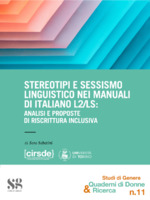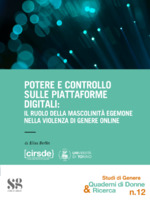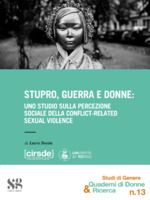Sfoglia documenti (13 in totale)
- Collezione: Studi di Genere. Quaderni di Donne & Ricerca
Sort by:
Stereotipi e sessismo linguistico nei manuali di italiano L2/LS: analisi e proposte di riscrittura inclusiva
The work aims at a reconnaissance of the current teaching material used in classes of Italian as a foreign language, bearing in mind the perspective of gender inclusive language and gender stereotypes.
A detailed linguistic analysis of copiuous textbooks – which was carried out upholding the approach of Italian linguist Alma Sabatini - highlights how the female world is still shaped through a male-dominant point of view. As a matter of fact, linguistich inclusivity often fails to be achieved, falling the Italian language into the grammatical gender languages type. The purpose of the analysis present in Chapter 3 is to show how a gender sensitive linguistic approach can be obtained and integrated into foreing language teaching material of Italian language, catering to all six level of the CEFR (Common European Framework of Reference for Languages) through degendering and engendering strategies.
On the other hand, the ambition of shaping multicultural beings across the world calls for the analysis of the socio-cultural aspects representing Italy in the aforementioned textbooks. This analysis (Chapter 4) recognizes five areas in which gender stereotypes, regarding the female sphere, are strongly pervasive and fail to represent the actual nuaces of life and personal identity - childhood, labour, family care, housekeeping, and physical appearence.
Lastly, Chapter 5 argues the outcomes of both the linguistic and socio-culultural analysis, in view of a future improvement of such teaching materials.
Potere e controllo sulle piattaforme digitali: il ruolo della mascolinità egemone nella violenza di genere online
This essay aims to investigate, through an analysis of the literature and the presentation of an experimental study, the main psycho-social risk factors underlying online gender-based violence, together with the way in which this form of abuse is perceived by the population.
The first chapter offers an overview of the main psychological, emotional and relational dynamics underlying gender-based discrimination and abuse (online or offline), together with the analysis of some behavioural practices frequently carried out in the context of the so-called “homosocial relationships” (Bird, 1996).
The second chapter of this work specifically addresses the presentation of the aforementioned environments. In this regard, the illicit production of sexually explicit material, the use of photo-editing techniques within a pornographic frame (deepfake-porn) and the submission of one's own genitals' photos without the recipient's consent (cyberflashing) represent some of the online gender-based form of abuse most frequently carried out, together with the non-consensual dissemination of intimate images. The last part of the second chapter presents the so-called “manosphere”, a virtual network made up of blogs, forums and online groups explicitly dedicated to the establishment of homosocial relationships based on nostalgia for the traditional patriarchal values.
The third chapter addresses the prevention of online gender-based violence. Since the introjection of sexist beliefs and gender stereotypes begins in early childhood, offering young people non-stereotyped grafic, linguistic and media representations is crucial, as well as addressing topics such as gender, affectivity and non-judgmental sexuality in primary and secondary school. On the other hand, an equally important role belongs to the media system, due to its ability to promote social norms introjection by the population (Cialdini and Trost, 1998).
Finally, the fourth chapter offers a brief presentation of this experimental research project. The study highlighted a strong relationship between individual levels of sexism, sexual double standard and right wing authoritarianism and, on the other side, people's ability (or inability) to feel empathy towards victims of online gender-based violence, emphasazing the need to address these variables in order to prevent the diffusion of the phenomenon.
Stupro, guerra e donne: uno studio sulla percezione sociale della conflict-related sexual violence
War has been, and still is, highly characterized by sexual violence. The present work takes a cue from the testimonies of victims of Conflict-Related Sexual Violence narrated by Lamb (2020) in “Our Bodies, Their Battlefield: What war does to Women” since, as the author writes, “You won’t find these women’s names in the history books or on the war memorials that we pass in our railway stations and town centres but to me, they are the real heroes.” (p.11).
Although war rape has existed for as long as conflicts themselves have existed, the legislative relevance of this crime as a crime against humanity, as a weapon of genocide, and as a war crime, only came into existence following the establishment of ad hoc international criminal tribunals for the former Yugoslavia and Rwanda.
Understanding the origin of sexual violence in armed conflicts is very complex as it is the result of multiple variables: from cultural norms to complex political and war strategies. Rape is often committed to terrorizing the population, breaking up families, destroying communities and even changing the ethnic composition of the next generations.
Many studies have focused on the socio-political analysis of this reality and the consequences at individual, social, and community levels. Few, however, have investigated the social perception of this issue. The main purpose of this exploratory research is to investigate whether people's perception of sexual violence can be influenced and modified by the war context in which this violence occurs, since, as Frese and colleagues (2004) point out, the characteristics of the context in which the violence occurred influence the participant’s perception of the event. In particular, the focus was on the recognition of the event as violence, the perception of severity, and the punitiveness of the perpetrators.



